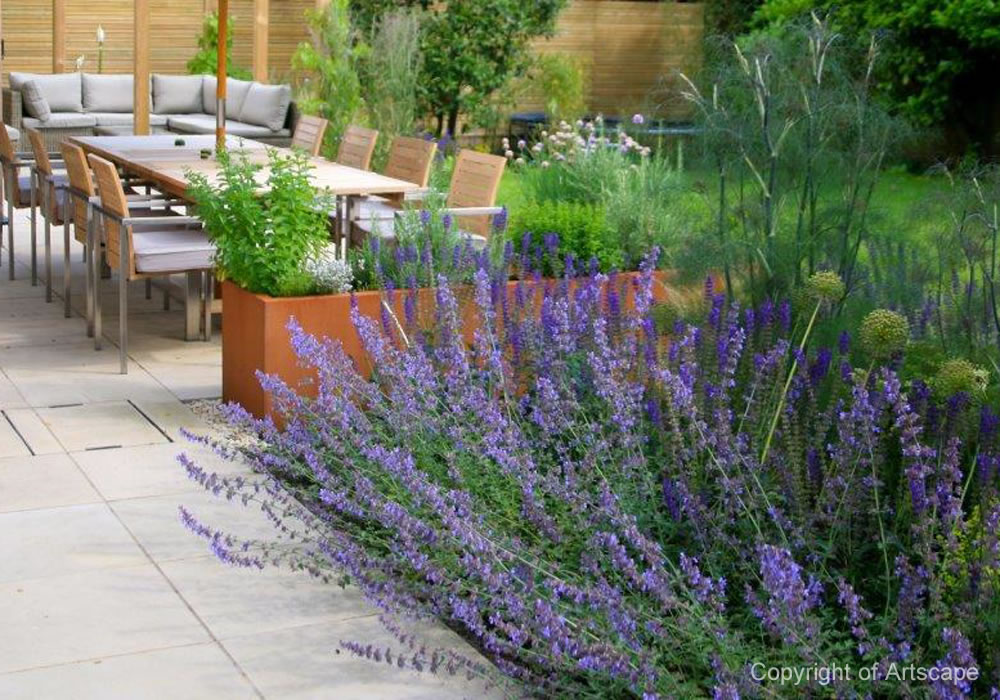The recent long spell of hot, dry weather here in the south of England has made many homeowners aware of the need to make their gardens more drought resistant. Here are some of the ways you can prepare your garden for future heatwaves.
Choose the right plants
Beautiful planting schemes can be achieved with plants that tolerate hot, dry conditions. Ceanothus, cistus, euphorbia, lavender, salvia, and sedum are a few of our favourites. Choose plants which have grey-green or hairy leaves that reflect the sun’s rays. Plants with glossy, waxy foliage such as sedum help to seal in moisture, and grasses and conifers with thin, narrow leaves lose very little water.
Plant well
Plant small, young specimens in the autumn so they have time to develop a strong root system before the hot, dry weather arrives. Smaller plants demand less water to help them establish too. The exception to the rule is Mediterranean plants such as lavender and rosemary, which are ideally planted in the spring when the soil is warmer, as new plants can suffer in during a cold, wet winter.
Mass planting is a good idea. Cover the ground with plants growing closely together so there is no bare soil which will dry out fast in the summer sun. You could complement your planting with a fountain or pond, which will have a lovely cooling effect.
 Lawns are surprisingly drought tolerant and will recover well, even if the grass has turned brown in the heatwave. Do also consider having a gravel garden, which is generally low maintenance.
Lawns are surprisingly drought tolerant and will recover well, even if the grass has turned brown in the heatwave. Do also consider having a gravel garden, which is generally low maintenance.
Water wisely
During a drought, ideally water late in the day or in the morning when the moisture will be retained for longer in the soil. Direct water to the base and roots of the plant. Water slowly so it soaks in well. Don’t water daily as the plants won’t develop any tolerance to going without water. It is better to give plants a good soaking than to water them little and often.
Prioritise plants that need water most, such as newly planted trees, shrubs, small seedlings and plants like Hydrangeas that dry out more quickly. Divide the rest of your garden into sections and soak each section in rotation. Established plants should be able to cope without water for a few weeks.
Conserve water
Capture and store as much rainwater as you can in water butts and other vessels. Create some shade around the butt, with planting or an awning, and stir the water occasionally to ensure oxygen is present. Do make sure large containers have a lid or mesh cover to prevent small creatures or children from falling in. If you have a large estate, consider installing underground tanks. For more water advice, view this video guide from the RHS: How to be wise with water in the garden
Dribble pipe irrigation systems work on low pressure and volume and providing they have a timer and pressure regulator can still be used under a hosepipe ban for most water authorities but do check with them first.
Mulch beds and borders
Improve soil quality and water retention by digging in large amounts of well-rotted, organic matter such as garden compost or farmyard manure into your soil in the autumn. Then mulch beds with a generous layer of organic matter when the soil is wet. Mulching is key to retaining soil moisture. Apply in spring and spread evenly in a 5-10cm layer but avoid building up around the base of plants. There are many types of mulch you could use: leaf mould, composted bark, mushroom compost, hop manure, cocoa shell, or gravel and pebbles. Avoid using wood chip as this depletes the plants of Nitrogen.
If you would love a beautiful, drought-tolerant garden, do get in touch with us at Artscape for an initial design consultation.





